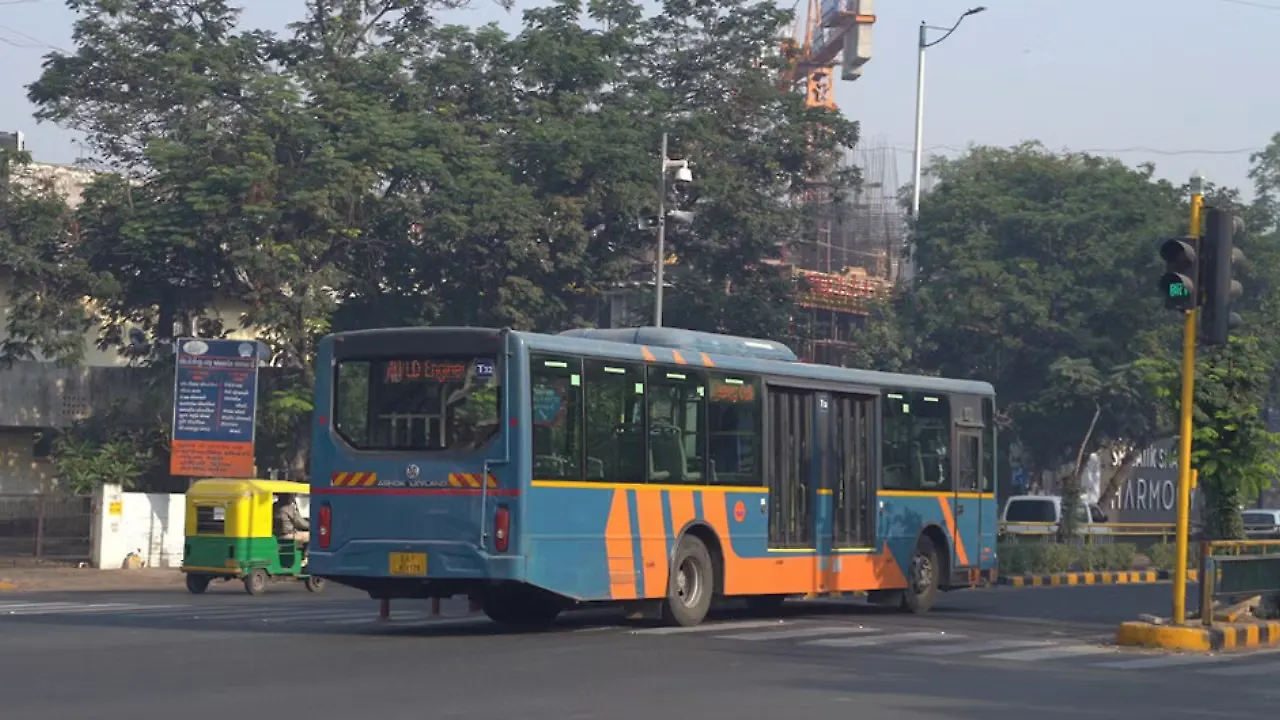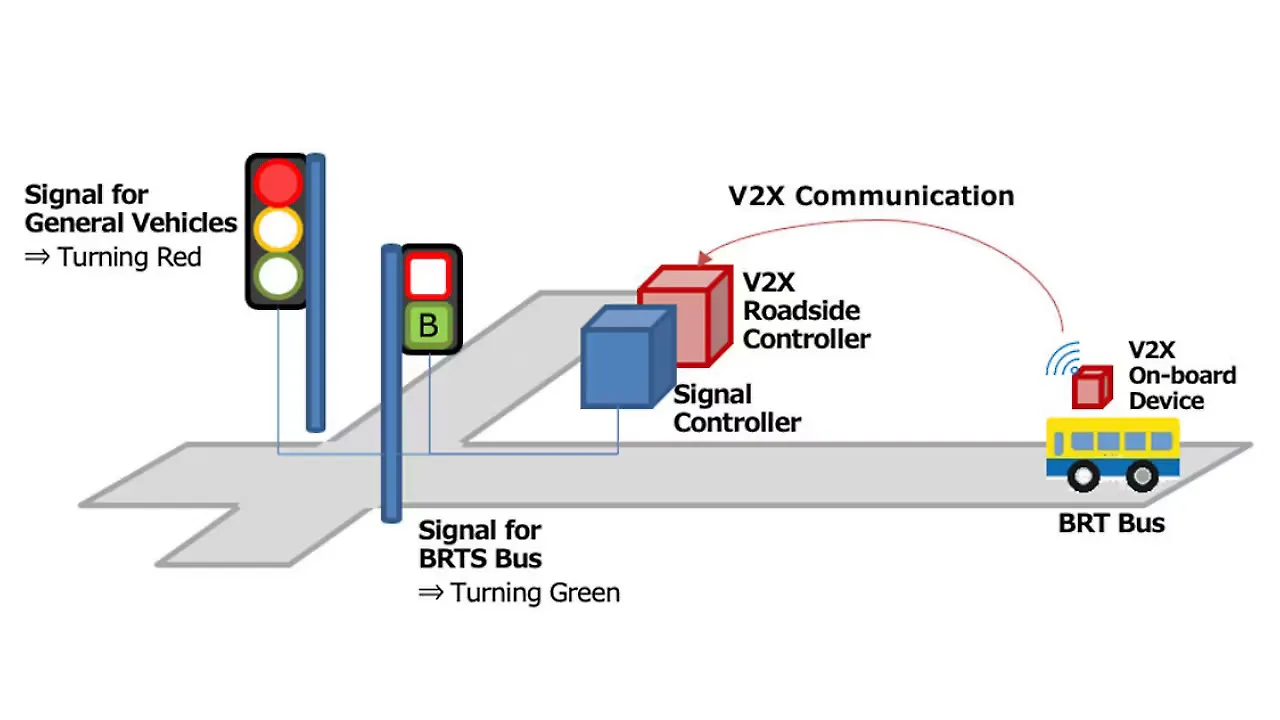
In a bid to encourage the general public to adopt Bus Rapid Transit System (BRTS) to contain emissions and help decongest the roads from traffic, Zero-Sum ITS Solutions India, with approval from Ahmedabad Janmarg, a special purpose vehicle of the Ahmedabad Municipal Corporation, conducted a demonstration showcasing a public transportation vehicle priority system.
Supported by the Ministry of Internal Affairs and Communications, JAPAN and ZERO-SUM, JAPAN, the project deployed systems that function over 600MHz band running on Japanese originated internationally standardised V2X communication technology.
This experiment demonstrated the use of a public transportation vehicle priority system in which a public transport vehicle such as a bus running on the Bus Rapid Transport System (BRTS) corridor communicates with traffic signals at the intersections through 600MHz band using V2X communication technology based on international standards that allow the bus to have priority passage at the intersections. This is the first demonstration of its kind in India for a public vehicle on a public road such as the BRTS corridor.
The BRTS corridor in Ahmedabad by Ahmedabad Janmarg, with a route length of over 103kms is one of the largest in the country. It has a fleet of 378 buses that cover 178 stations, completing over 3,656 trips daily. It is rated as one of India's best Mass Rapid Transport Systems and served as an ideal ground for conducting such an experiment.
Experiment
This technology prompts traffic signals installed enroute path of buses on the BRTS corridor to identify the approach of the buses. Upon the detection of an approaching bus, the traffic signal will identify the speed and distance of the approaching bus and thereafter map the traffic signal cycle to turn green by the time the bus reaches the intersection, thereby enabling the bus to get signal-free passage at the intersections safely and reduce the travel time to its destination.

Several V2X communication devices that function on the 600 MHz band were installed on buses that run on the BRTS corridor and at a busy traffic intersection on the BRTS corridor in Ahmedabad. When a bus equipped with a V2X communication device approaches the traffic intersection at which a V2X communication device is installed, the devices identify each other at over 400 meters.
The V2X devices communicate with each other, and the information that the bus is approaching the intersection along with parameters such as speed and position is immediately transmitted to the signalling system, enabling the system to modify and optimise the running signal cycle to turn green by the time the bus approaches within 100 to 150 meters of the intersection. It allows the priority passage of the bus over other modes of transportation at the intersection, enabling a reduction in travel time of the bus. Upon the bus crossing the signal intersection, the system identifies the same and thereafter switches off the green corridor system for the BRTS lane, thereby ensuring a return to the normal signal cycle for the non-BRTS lanes. This system has helped demonstrate that a priority system for public transportation vehicles on public roads can be implemented.
The experiment was conducted at the Panjrapool Traffic intersection on the BRTS corridor in Ahmedabad. It was chosen as it is an important intersection on the BRTS corridor.
Results
Upon completion of the demonstration, it was found that the emergency vehicle priority system that uses V2X communication technology running on 598-608 MHz that follow international standards set forth by ITU-R M.2084-1 and the Japanese standard message set of ITS Connect TD-001, are very stable, as the communication between the V2X devices was confirmed. Furthermore, it was also observed that through the integration of the V2X system with the signalling system, the traffic signal in the direction of the approaching bus was successfully able to identify the bus and turn the traffic signal to green for the BRTS corridor, to provide priority passage to the bus at the intersection.
The system implementation resulted in a reduction of 86.2% from the average waiting time of 33.1 seconds of the bus at the intersection without the system to the average 4.5 seconds with the system. And the bus travel time also reduced by about 40%. In addition, the signal cycle was successfully optimised to allow a safe change of signal that not only provides priority passage to the BRTS corridor but also optimised the non-BRTS lanes when there was no bus approaching the intersection. This allowed non-BRTS lanes to receive additional green cycle time that would have otherwise been wasted through allocation to the BRTS lane even when no bus was passing through the intersection. The experiment helped demonstrate that the system does not have any adverse effect on non-BRTS lanes or other vehicles on the road and, in fact, when implemented over a wider area, will help in reducing the waiting time for non-BRTS lanes as well.
The 598-608 MHz band used in the demonstration experiment was acquired under an experimental license from the Wireless Planning and Coordination (WPC) Wing of the Department of Telecommunications, Ministry of Communications, India.
Future Initiatives
With the completion of the trial period of the experiment, Zero-Sum will have a public demonstration of the system to Ahmedabad Janmarg and Ahmedabad Municipal Corporation.
From the initial results gathered from the experiment, Vishal Khanama, General Manager, Ahmedabad Janmarg, said, 'The initial results seen from the experiment seems very promising, and we are proud to be associated with Zero-Sum to conduct such a trial for the first time in the country. Ahmedabad Janmarg is looking for improving the on-time performance and time-frequency of its buses so that we aim at creating customer delight and this is one such initiative that we believe can make the travel experience of the commuters better and refine the overall quality of life for the citizens of Ahmedabad. We are impressed that the system allows for both priority of BRTS buses and at the same time does not cause any interruption for general traffic. We will study the results in detail and review the feasibility of expanding the V2X system across a wider area of the BRTS corridor in Ahmedabad.'
Chikara Kikuchi, Managing Director, Zero-Sum ITS Solutions India, said, 'Last year, we had successfully demonstrated the effectiveness of the V2X system in creating automated green corridors for emergency vehicles. The results of the experiment conducted this year on the BRTS corridor in Ahmedabad also seem very encouraging. We will shortly look at creating a standardised solution that can be implemented by bus corporations across the country on their BRTS corridors and by municipalities for providing priority passage for their emergency vehicles.'